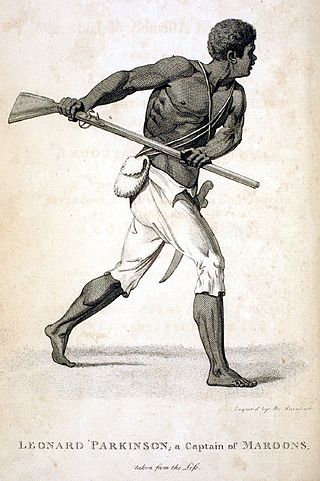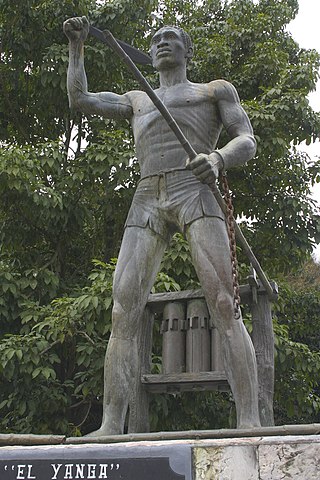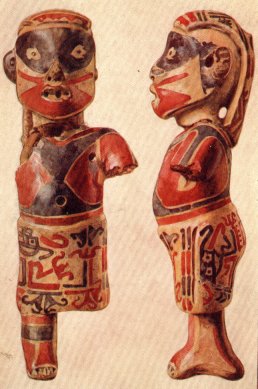
Sir Francis Drake was an English explorer and privateer best known for his circumnavigation of the world in a single expedition between 1577 and 1580. This was the first English circumnavigation, and third circumnavigation overall. Having started as a simple seaman, in 1588 he was part of the fight against the Spanish Armada as a vice-admiral.

Maroons are descendants of Africans in the Americas and Islands of the Indian Ocean who escaped from slavery and formed their own settlements. They often mixed with indigenous peoples, eventually evolving into separate creole cultures such as the Garifuna and the Mascogos.

Nombre de Dios is a city and corregimiento in Santa Isabel District, Colón Province, Panama, on the Atlantic coast of Panama in the Colón Province. Founded as a Spanish colony in 1510 by Diego de Nicuesa, it was one of the first European settlements on the Isthmus of Panama. As of 2010 it had a population of 1,130 people.

The Black Seminoles, or Afro-Seminoles, are an ethnic group of mixed Native American and African origin associated with the Seminole people in Florida and Oklahoma. They are mostly blood descendants of the Seminole people, free Africans, and escaped former slaves, who allied with Seminole groups in Spanish Florida. Many have Seminole lineage, but due to the stigma of having mixed origin, they have all been categorized as slaves or freedmen in the past.
Bayano, also known as Ballano or Vaino, was an African enslaved by Portuguese who led the biggest slave revolts of 16th century Panama. Captured from the Yoruba community in West Africa, it has been argued that his name means idol. Different tales tell of their revolt in 1552 beginning either on the ship en route, or after landing in Panama's Darien province along its modern-day border with Colombia. Rebel slaves, known as cimarrones, set up autonomous regions known as palenques, many of which successfully fended off Spanish control for centuries using guerrilla war and alliances with pirates, or indigenous nations who were in similar circumstances.

Gaspar Yanga — often simply Yanga or Nyanga was an African who led a maroon colony of enslaved Africans in the highlands near Veracruz, Mexico during the early period of Spanish colonial rule. He successfully resisted a Spanish attack on the colony in 1609. The maroons continued their raids on Spanish settlements. Finally in 1618, Yanga achieved an agreement with the colonial government for self-rule of the maroon settlement. It was later called San Lorenzo de los Negros, and also San Lorenzo de Cerralvo.
Guillaume Le Testu, sometimes referred to as Guillaume Le Têtu, was a French privateer, explorer and navigator. He was one of the foremost cartographers of his time and an author of the Dieppe maps. His maps were distinguished by their sophistication and detail; they influenced generations of cartographers, navigators and explorers.

In the history of Panama, the earliest known inhabitants were the Cueva and Coclé tribes, but they were drastically reduced by disease and fighting when the Spanish arrived in the 16th century. But some moved out of Panama to have children and increase population.

Afro-Panamanians are Panamanians of African descent. The Afro-Panamanian population can be mainly broken into one of two categories "Afro-Colonials", Afro-Panamanians descended from slaves brought to Panama during the colonial period, and "Afro-Antilleans," West Indian immigrant-descendants with origins in Trinidad, Martinique, Saint Lucia, Guadeloupe, Dominica, Grenada, Haiti, Belize, Barbados, and Jamaica, whose ancestors were brought in to build the Panama Canal. Afro-Panamanians can be found in the towns and cities of Colón, Cristóbal and Balboa, the Río Abajo area of Panama City, the Canal Zone and the province of Bocas del Toro.
Yanga Municipality is a municipality located in the southern area of the Mexican state of Veracruz, about 80 km from the state capital of Xalapa. It was formerly known as San Lorenzo de los Negros or San Lorenzo de Cerralvo. In 1932 it was renamed after Gaspar Yanga, the cimarron leader who in 1609 resisted attack by Spanish forces trying to regain control of the area.
The western Caribbean zone is a region consisting of the Caribbean coasts of Central America and Colombia, from the Yucatán Peninsula in southern Mexico to the Caribbean region in northern Colombia, and the islands west of Jamaica are also included. The zone emerged in the late sixteenth century as the Spanish failed to completely conquer many sections of the coast, and northern European powers supported opposition to Spain, sometimes through alliances with local powers.
John Oxenham was the first non-Spanish European explorer to cross the Isthmus of Panama in 1575, climbing the coastal cordillera to get to the Pacific Ocean, then referred to by the Spanish as the Mar del Sur.
Captain John Marchant served under Sir Francis Drake from 1585 to 1596, thus participating in some of the most important seafaring expeditions and naval encounters of the day. He lost his life near Nombre de Dios, Panama, a few weeks before Drake's own death.
Andrew Barker was an Bristolian merchant and Elizabethan privateer.

Afro-Venezuelans are Venezuelans of African descent. Afro-Venezuelans are mostly descendants of enslaved Africans brought to the Western Hemisphere during the Atlantic slave trade. This term also sometimes refers to the combining of African and other cultural elements found in Venezuelan society such as the arts, traditions, music, religion, race, and language.
The Bayano Wars were armed conflicts in the Isthmus of Panama that occurred between the Bayano of Panama and the Spanish crown. The First War of the Bayano took place from 1548 to 1558, while the Second War took place from 1579 and 1582. Slavery, practiced since the early sixteenth century in Panama, brought many enslaved people from Africa to Spanish America. This brought successive slave uprisings against the rulers of the time, which was the origin for the Bayano Wars.

Drake's Assault on Panama also known as the Defence of Panama was a military event that took place in January 1596 during the Anglo–Spanish War. An English expedition under the command of Francis Drake and Thomas Baskerville attacked the Spanish Main via Nombre de Dios in order to cross the isthmus of Panama. Ravaged with dysentery and other diseases the English were repelled and defeated. Drake would die of the former and the expedition was forced to retreat back to England all the while harassed by the Spanish.

Francis Drake's circumnavigation, also known as Drake's Raiding Expedition, was an important historical maritime event that took place between 15 December 1577 and 26 September 1580. The expedition was authorised by Queen Elizabeth I and consisted of five ships led by Francis Drake. Termed a 'voyage of discovery', it was in effect an ambitious covert raiding voyage and the start of England's challenge to the global domination of Spain and Portugal.

Francis Drake's expedition of 1572–1573 was an uncommissioned profiteering voyage by Sir Francis Drake in the western and southern quarters of the Caribbean Sea.
John Noble was an Elizabethan privateer who cruised the Caribbean coast of Veragua.










